Milan has admittedly very tough competition when it comes to planning an Italian holiday. It may not have the star power of Florence, Rome, and Venice, but the city is much more than the dynamic business powerhouse and fashion and design capital that first comes to mind.
I included Milan on my first trip to Italy years ago, and the city’s appeal as a visitor destination has only grown with time, particularly after the 2015 World’s Fair. Expo Milano focused on food, which has always been a strong asset for Milan. I had only a day on that trip to see the highlights, which remain vividly in my mind, including the spectacular Duomo, Da Vinci’s Last Supper, and the stunning Galleria Vittorio Emanuele II.
Not only is Milan an excellent hub to arrive in the country at its international airport, but the city also has plenty of attractions to fill several days of a packed itinerary when visiting Italy. There are great museums like the Brera, historic sites like the Sforzesco Castle built by Renaissance dukes and even containing Michelangelo’s last piece of sculpture, and churches like St. Maurizio with amazing frescoes.
Discover the different sides of Milan with a visit to the canals of the Navigli district, a high-end shopping ramble through the so-called Quarter of Gold and an aperitivo crawl in the city that has perfected the art of the pre-dinner drink and snacks.
Milan is in the northern region of Lombardy, and its level of organization and business savvy is more akin to its northern neighbors like Switzerland than the more animated southern part of Italy with cities like Rome. Yet it is a beguiling stop on any Italian itinerary.
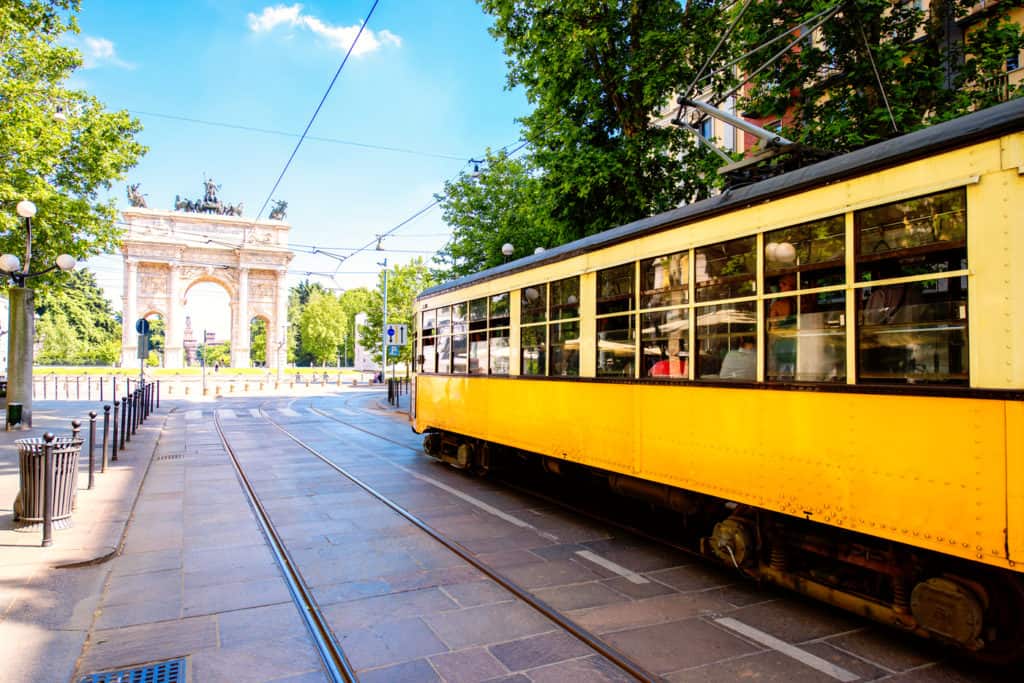
Getting Around Milan
Milan is a large city, though many of the most interesting sights are in the central core. But Milan does offer several visitor cards that might be of interest as you plan how to best navigate the city.
For public transport, there’s the Milano Card which offers full access to Milan’s transit options for 24, 48 or 72 hours. The cost of the card is 11 euro for one day, 17 euro for two days and 19.50 euro for three.
If you will be visiting museums during your trip, consider the Milan Pass, a 48-hour card that offers free access to many museums, discounts at shops and restaurants as well as free public transport for 69 euro, or for 79 euro if you’d like to add in the city’s hop on, hop off red double-decker sightseeing bus service.
Can’t Miss Milan Sights and Experiences
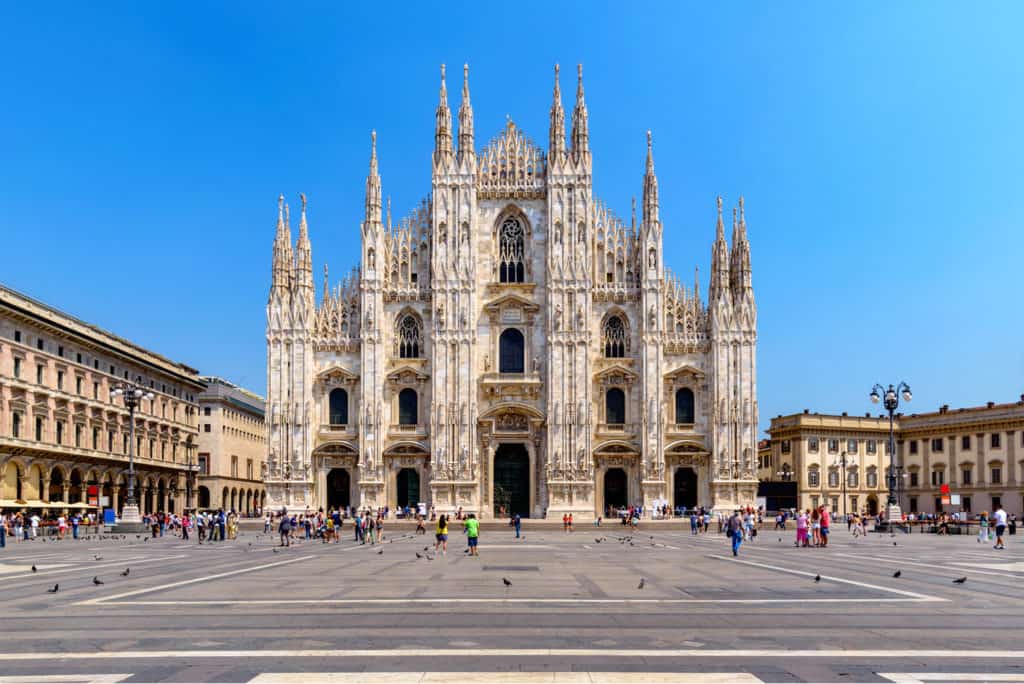
Milan’s Fabulous Cathedral: Il Duomo
Il Duomo is the Italian word for cathedral, and Milan’s Gothic Duomo is the star attraction of the city. This Gothic beauty overwhelms you with its size and majesty as you enter the car-free Piazza del Duomo.
It took almost six centuries to complete this marvelous cathedral with construction starting in 1386 by the then ruling Visconti family and not competed until 1965 when the large bronze doors were added. It has 135 marble spires gracing its roof and over 3,000 statues. The marble was transported from quarries near Lake Maggiore and the city used its canals to bring the stone close to the Duomo’s site.
Atop the cathedral’s tallest spire stands a gilded statue of the Virgin Mary, affectionately called La Madonnina. It’s the symbol of Milan, and by law since 1930, no building can be built higher than the Madonna.
The church is one of the largest in the world, seating 40,000. The interior is divided into five aisles by 52 columns. The spectacular stained-glass windows are one of the chief highlights. The windows are lit from inside, so can be admired at night as well. One of its most noteworthy statues is that of St. Bartholomew, the saint who was skinned alive for his beliefs.
But the part of the visit I most remember is the visit to the rooftop terraces where you can walk amidst the forest of pinnacles and spires and get closer views of the gargoyles and the Madonna statue on top. The views through the spires are spectacular of the city and on to the mountains. You can choose to take an elevator or stairs up to the terraces.
There’s a rather complex schedule of fees depending on what parts of the Duomo complex you’d like to see. Here’s the list:
- Only the Cathedral: € 5 (includes the crypt and archaeological area)
- Only the Duomo Museum € 5
- Rooftop via stairs: € 10
- Rooftop via lift: € 14
- Cathedral and rooftop by lift: € 20
- Cathedral and rooftop by stairs: € 15
Tickets are available online and advance purchase is recommended.
To get full details on the history of the beautiful Duomo, you can take a 1.5 hour guided tour with rooftop terraces access for $44.03 per person.
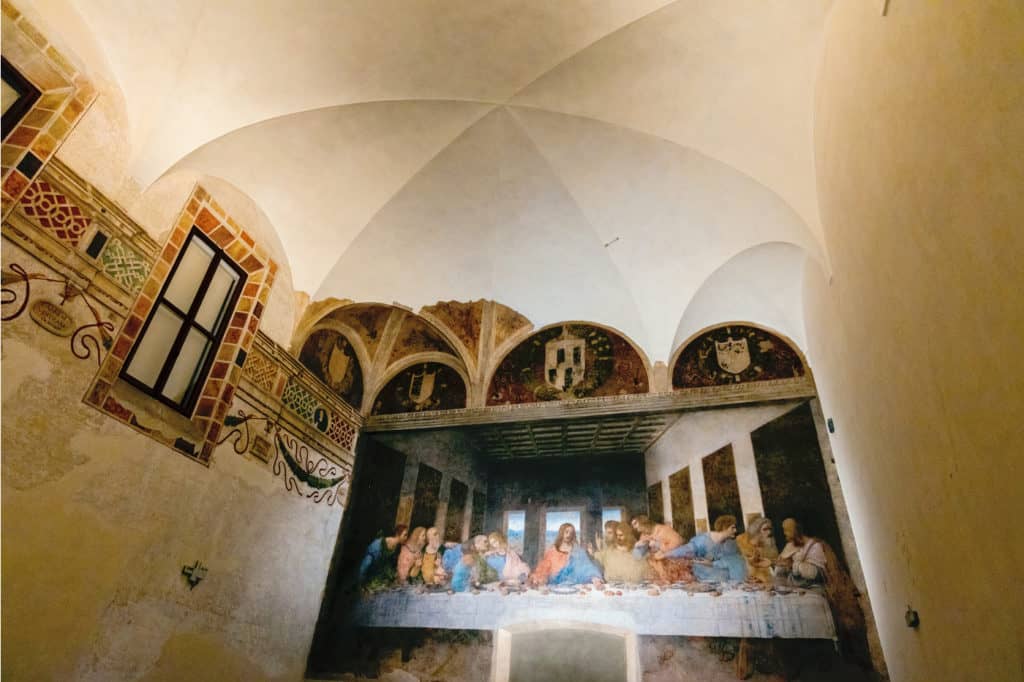
Da Vinci’s Last Supper
There’s a certain adrenaline rush when you first get to see a world-famous painting in person for the first time. You remember your encounter with The Mona Lisa or the Sistine Chapel, and it’s no different when you are ushered into the church refectory of Santa Maria delle Grazie to see The Last Supper, the masterwork of Renaissance genius Leonardo da Vinci.
How did the Last Supper end up being painted here? The Duke of Milan hired Leonardo in 1481 to be his court artist. He stayed in this role for 18 years, producing some of his most important work. The Last Supper is Milan’s top attraction, and it is a wonder that it has even survived to this day. It’s found on the back wall of the dining hall or refectory in Santa Maria delle Grazie, a Dominican church and convent. But this is such a popular sight that it has its own separate entrance and fees from the church itself.
Start with da Vinci’s own choice of how to paint the fresco. Instead of following the usual technique of applying his paint to a wet plaster, allowing the paint to adhere as it dried, he opted for a dry fresco technique, using his oil paints on a dry plaster, which gave him much more time to create his painting (it was completed between 1495 and 1498). But it did not allow the paint to properly adhere to the surface, and it began flaking away soon after it was completed!
There have been multiple attempts at restoration with varying levels of success. WWII bombs blew apart several of the refectory walls where the painting resides, but miraculously spared the Last Supper. Even the monks had a hand in impacting the artwork, as they cut a door into the wall that took away Christ’s feet!
But what remains is still a stirring experience for art lovers. It renders the moment when Christ tells his disciples that one of them will betray him. The reactions on the faces of each are dramatic and deserve study. Judas has his bag of silver coins in his hand. But your time is limited as visitors are only given 15 minutes within the refectory hall to see the painting before being ushered out.
Advance planning for ticket purchase is essential, as the Last Supper is the biggest tourist draw in the city. The entry fee is 15 €. Or join a small group tour that includes a skip-the-line ticket for $77.78 per person.
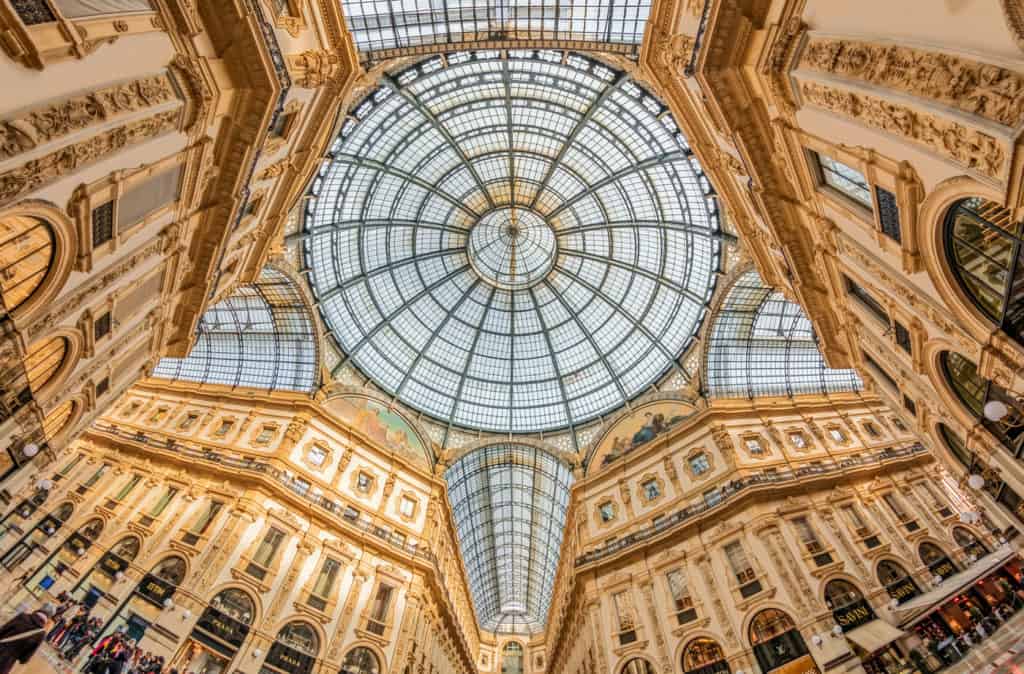
Galleria Vittoro Emanuele II
Although I wouldn’t consider myself a devoted shopper, sometimes the environment for shopping is by itself so spectacular that it makes me appreciative. That’s the case with the Galleria Vittorio Emanuele II, the world’s first enclosed shopping arcade and to my mind still the most beautiful.
The gallery was built from 1865-77 by architect Giuseppe Mangoni, who unfortunately never saw its debut as he died in a fall from the scaffolding the day before it opened in 1878. It was designed to mark Italy’s unification under King Vittorio Emanuele II; the decorations incorporated the coats of arms of various Italian cities.
Situated conveniently next to the Duomo, the marble, iron, and glass arcade is a beautiful building, and houses many upscale shops, restaurants, and cafes. But it’s the building’s artistry that will appeal to you. Look at the glass dome and admire the paintings at the base representing Europe, Asia, Africa, and America.
The decorations continue with the beautiful mosaic tiled floors of the gallery, which bear the insignias of four noted northern Italian cities. Turin is represented by a bull. A legend grew that if you spun around on the bull’s private parts, you would have good luck. Tourists and locals alike took this too much to heart, and there is now a hole where the poor bull’s privates used to be!
This is a great place to take a pause in your itinerary and people watch while taking an admittedly expensive coffee or snack at one of the gallery’s cafes or restaurants.
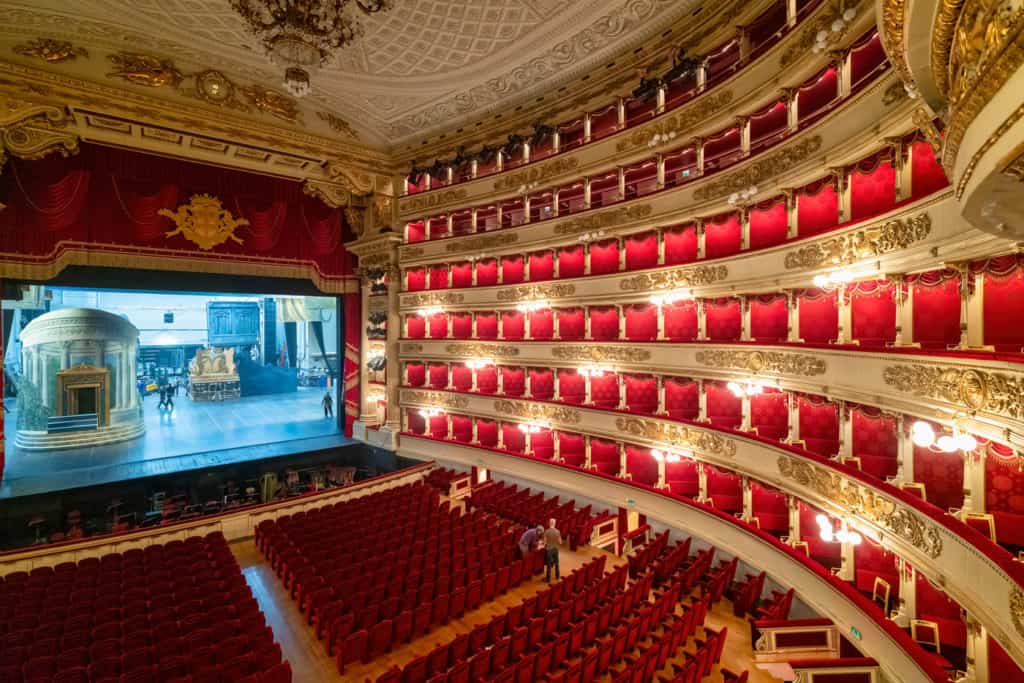
La Scala Opera House and Museum
Think of music in Milan and what comes to mind before La Scala? It’s as famous an opera house as La Fenice in Venice, and some of the greatest names in Italian opera have premiered or performed their works on this stage, luminaries like Verdi, Puccini, and Rossini. Opened in 1778, La Scala can fit 2,000 patrons in its luxurious red and gold interior.
Of course, the best way to experience the theater is by attending a performance (there’s more than just opera, as the schedule includes ballet and concerts as well). But if you can’t attend a show, you can take a guided tour in English for € 25.75, or visit the museum, which affords you at least a glimpse of the sumptuous interior. The La Scala museum provides a history of this beautiful temple to opera, with costumes, portraits, and other memorabilia for an entry fee of € 9.75.
This 3-hour tour takes in the city’s highlights including a visit to the La Scala museum for $138.83 per person.
Surveying the Top Museums
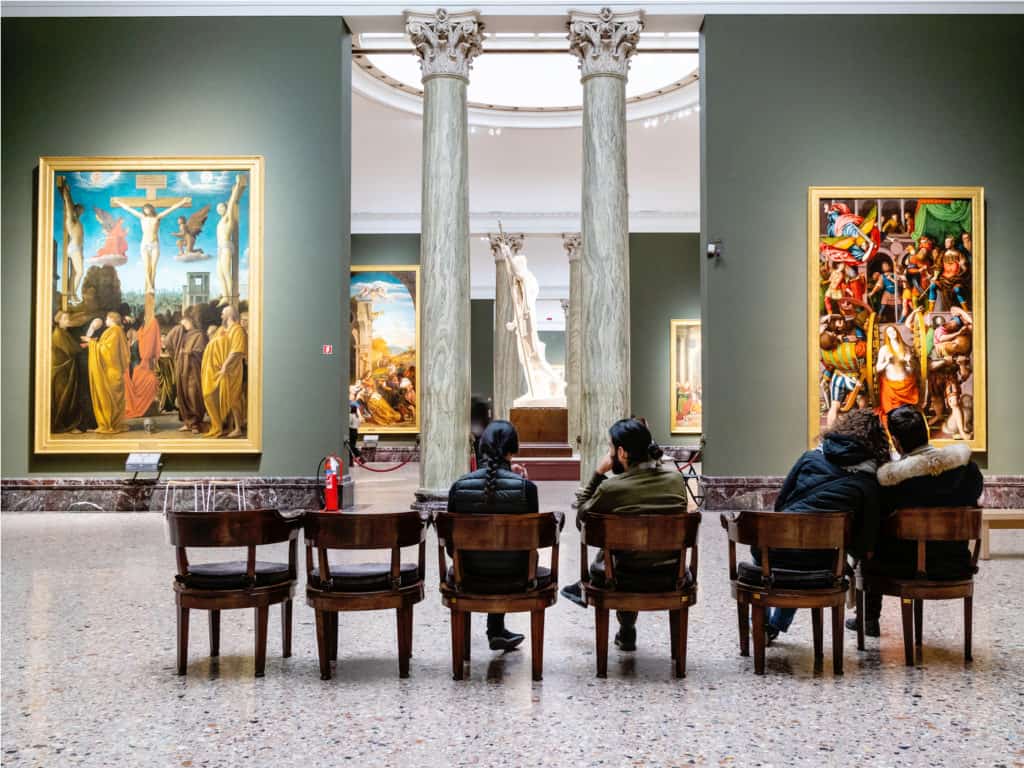
Brera Art Museum
Situated in the charismatic Brera neighborhood, the Brera Museum is an excellent collection of primarily Italian paintings housed in the beautiful late 17th century Palazzo Brera.
Milan’s premier art collection wraps around a two-story arcaded courtyard, presenting a wonderful survey of Italian art in its 38 rooms. Much of the art came into the collection because of acquisitions from churches that were closed or torn down. The strongpoint of the collection are paintings by northern Italian artists.
Here you’ll see masterworks by the likes of Titian, Caravaggio, Raphael, Rembrandt, Bellini, and Tintoretto. Several of the most acclaimed works include Raphael’s Marriage of the Virgin, Caravaggio’s Supper at Emmaus, and Francesco Hayez’s The Kiss. But it’s not just Renaissance era work you’ll find here, as there are also some modern works by Modigliani, Picasso, and Braque among others.
Don’t miss the lovely Orto Botanico di Brera, a charming garden in an inner courtyard, a tucked-away, hidden oasis of flowers, trees, and pools.
The museum’s entry fee is € 15.
Join a two-hour Secrets of the Brera and Brera District tour for $128.67 per person.
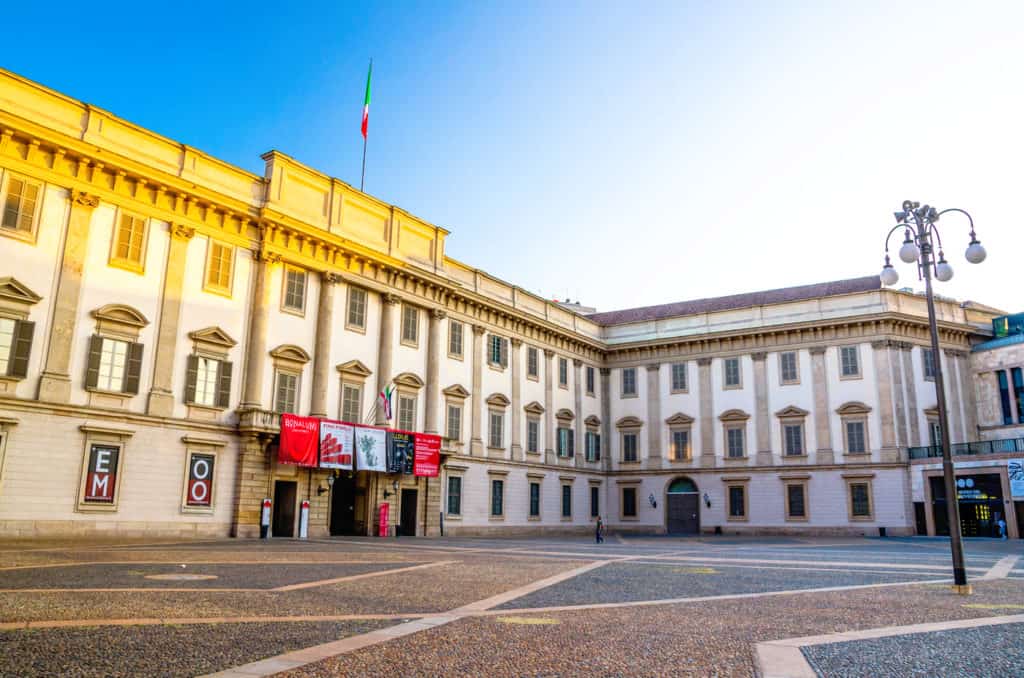
Duomo Museum
The Duomo Museum presents a beautiful collection of the artwork and history of the Duomo, with over 200 works of art presented chronologically related to the cathedral, including paintings, stained glass, sculptures and a wooden model of the Duomo from 1519. I liked the room full of gargoyles! One of the top pieces on display is Tintoretto’s Jesús and the Moneylenders.
The museum is not located in the Duomo, but rather nearby on the ground floor of the Royal Palace. The entry fee is € 5.
And museums for those with more time….
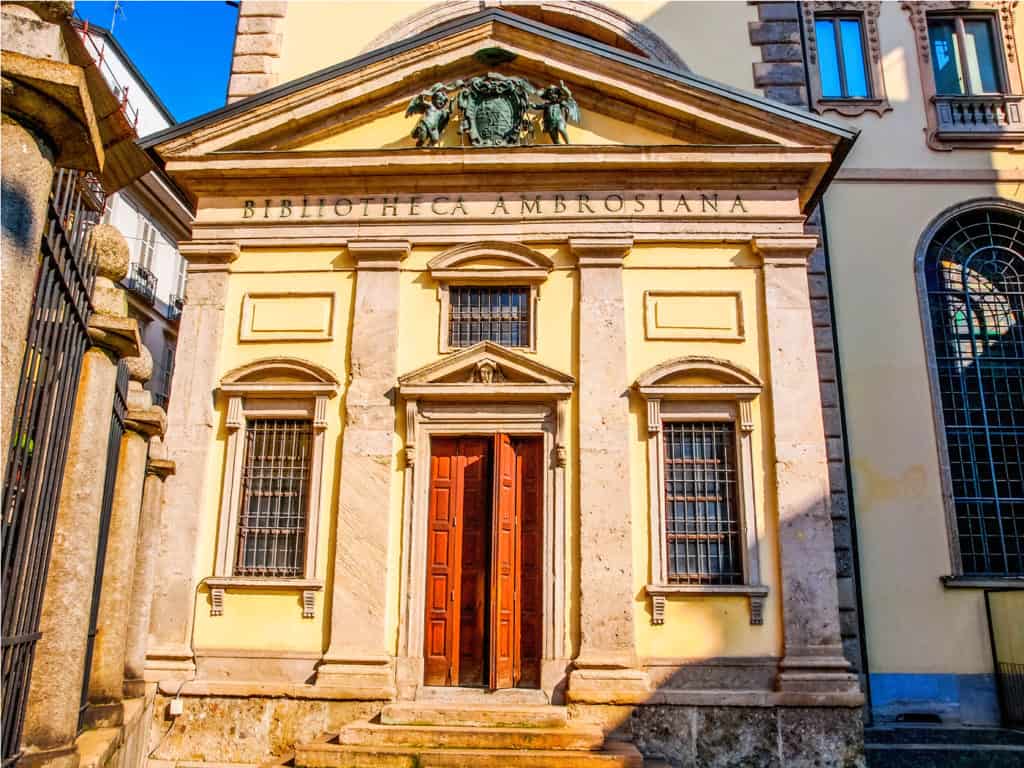
Pinacoteca Ambrosiana
The Pinacoteca Ambrosiana is a lesser-known gem in Milan, filled with Renaissance art and housed in a beautiful library. The most famous holding is the Codex Atlanticus, Leonardo da Vinci’s artistic and scientific journals. The codex is a 12-volume set of drawings and writings representing Leonardo’s full sweep of work between 1478-1519.
The pinacoteca art gallery was founded in 1618 through a donation by Cardinal Federico Borromeo. The emphasis is on Italian art from the 15th to early 20th centuries. Some of the best paintings to seek out are Caravaggio’s Basket of Fruit, Titian’s Adoration of the Magi, and Botticelli’s Madonna del Padiglione. There is also Raphael’s cartoon (a preparatory drawing) for the School of Athens, one of the best-known frescos in the Vatican Museums.
The entry fee is € 15.
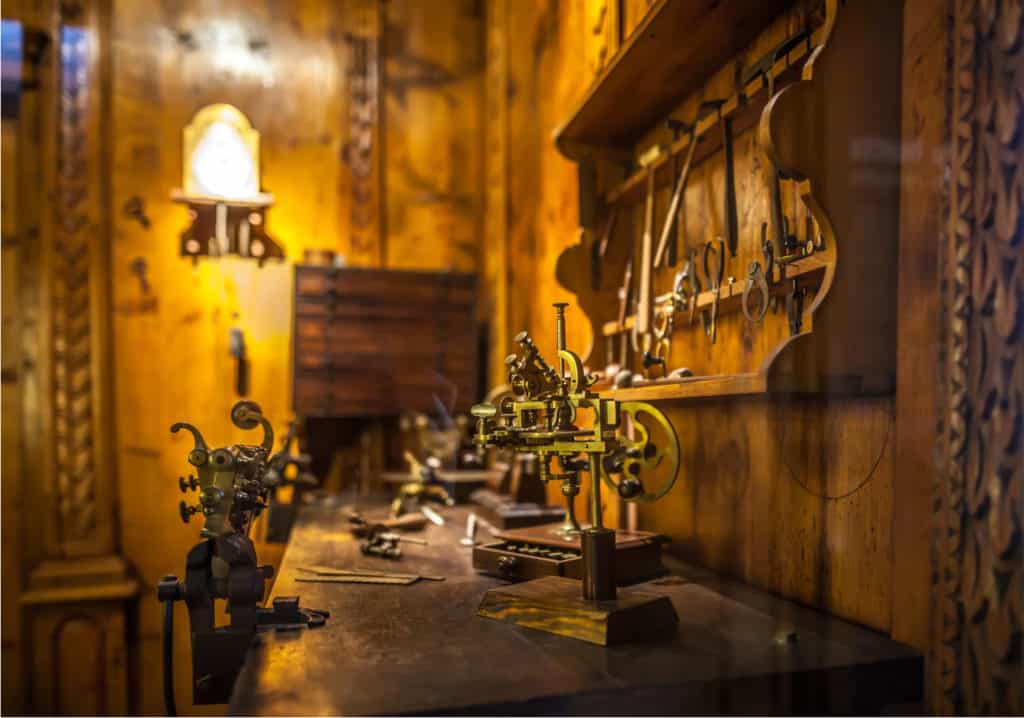
Leonardo da Vinci Museum
The Leonardo da Vinci National Museum of Science and Technology features more than 30 models of da Vinci’s inventions, from scientific instruments to instruments of war. Built inside of a former Renaissance monastery, the museum has a staggering array of scientific exhibits on such wide-ranging topics as automobiles, rail transport, aviation and even a WWII submarine.
Depending on your interests in these topics will determine how much time you want to spend, but the exhibits on da Vinci’s inventions warrant a trip to the museum.
Full price tickets cost €10.
To help sort out the highlights of this immense museum, you could take a 1.5 hour guided museum tour. These are offered for $180.59 per group for up to 15 people.
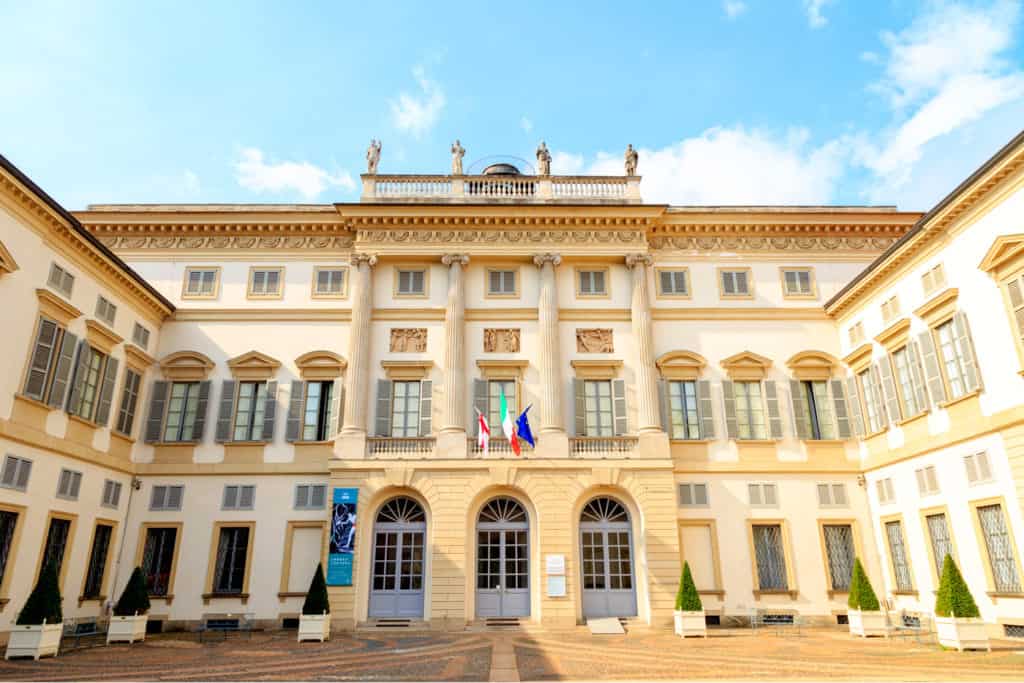
Modern Art Gallery
Galleria D’Arte Moderna, nicknamed “GAM,” is Milan’s modern art gallery, with work spanning the period from 1800 to 1900. The collection is housed in a beautiful Neoclassical villa, built between 1790 and 1796. Napoléon lived here briefly with Empress Josephine.
The collection emphasizes 18th- and 19th-century Italian works, but also has some 20th-century Italian pieces as well as some international works by Van Gogh and Picasso. The museum affords the chance to learn more about modern Italian artists such as Boccioni and Modigliani in a very attractive setting. The entry fee is € 5.
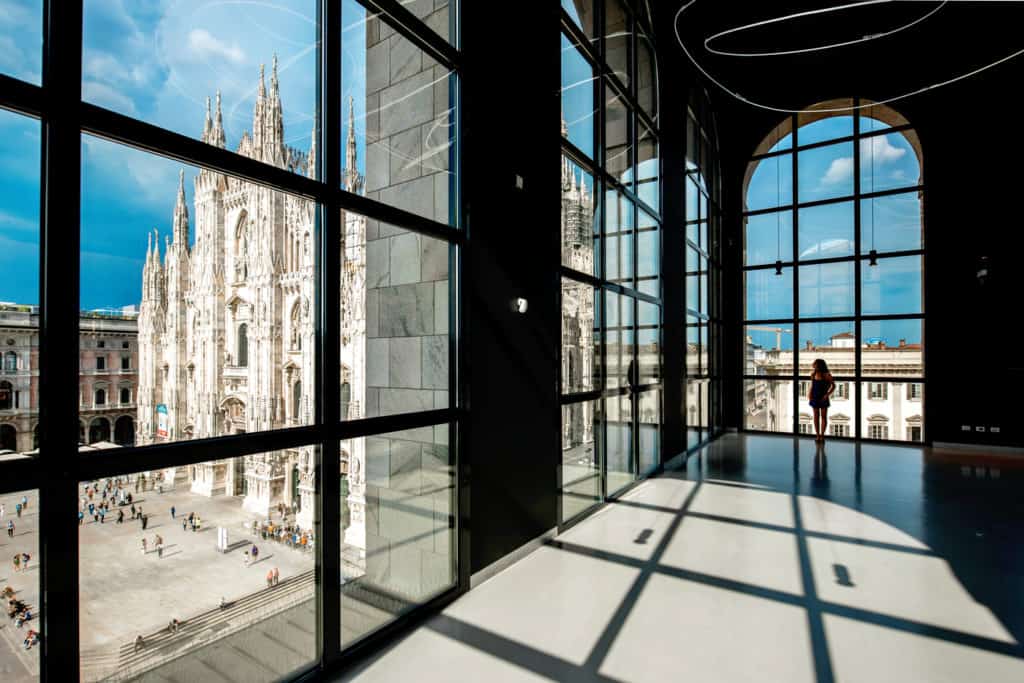
Museum of the Twentieth Century
The Museo del Novecento was founded in 2010, and is dedicated to 20th century art. It is housed in the historic Palazzo dell’Arengario in Piazza del Duomo, from which perch Mussolini used to give speeches in the 1930s. The collection of over 4,000 works illustrates the development of 20th century Italian Art.
First, you’ll ascend a spiral ramp reminiscent of the Guggenheim Museum in New York up to the third-floor museum entrance. Come here to learn more about the Italian artists like Futurists Boccioni and Severini, plus works by Giorgio de Chirico and sculptures by Marini. There are also some works by other European artists including Picasso and Matisse.
The museum’s setting on the Piazza del Duomo means you also get great views of the Duomo!
The entry fee is 10 euro.
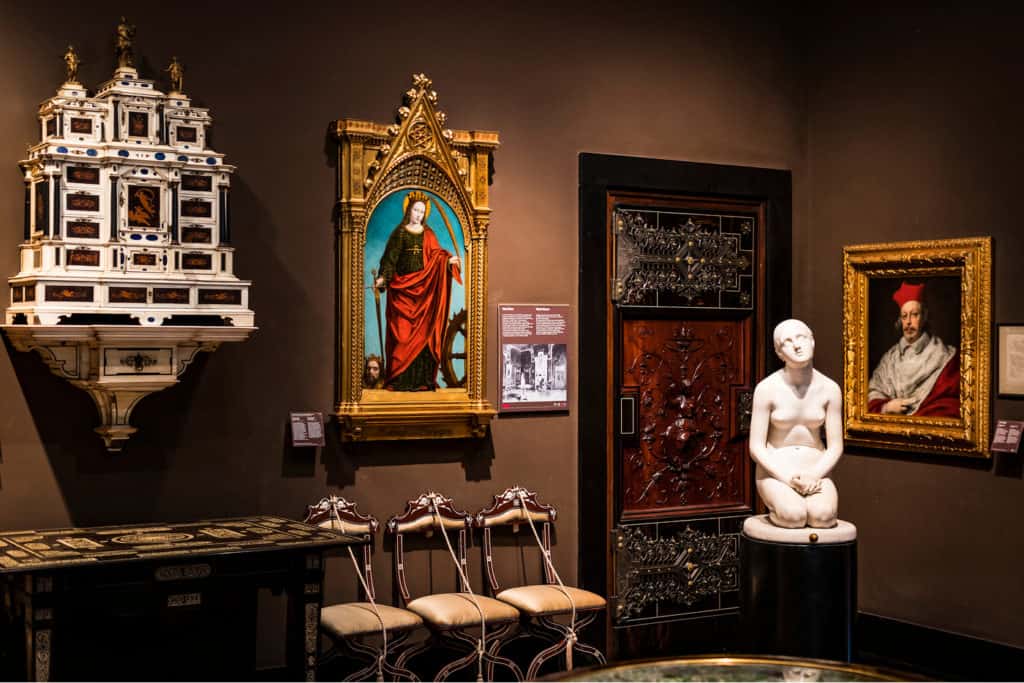
Poldi Pezzoli Museum
The eclectic Poldi Pezzoli Museum art collection was formed from an 1879 donation of artwork and decorative arts by aristocrat Gian Giacomo Poldi Pezzoli. It is beautifully presented in his luxurious former palazzo.
Wandering through the richly decorated rooms, you’ll see a dazzling array of Oriental rugs, rare books, arms and armor, glass, china, and paintings. There is a collection of 150 watches and clocks from the Renaissance to the late 1800s.
Other highlights include an intricate Flemish Armillary Sphere from 1568 that showed contemporary understanding of planetary movement, paintings by Botticelli and Piero della Francesca in the Golden Room and scenes from Dante’s Divine Comedy in stained glass. The woman captured in Antonio Pollaiuolo’s Portrait of a Lady is the source of the museum’s logo.
The entry fee is 14 € for adults.
Admire Milan’s Beautiful Churches
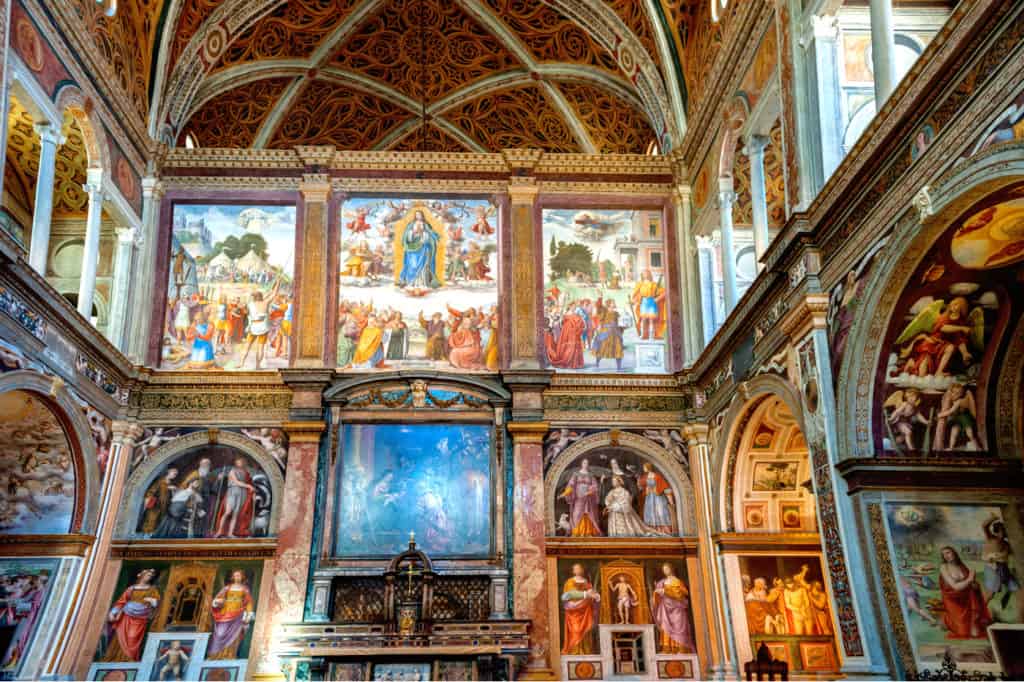
Church of San Maurizio
The 8th century Church of San Maurizio hides an amazing interior behind its plain façade. But this is probably Milan’s most beautiful church. Inside you’ll find a riot of colorful frescoes created in the 16th century chiefly by Bernardino Luini, a northern Italian painter belonging to Leonardo’s circle. They are so impressive that the collection has been called the Sistine Chapel of Milan! Many of the frescoes depict members of the ruling Sforza family who paid for the chapel’s decoration.
There is no fee to enter the church.
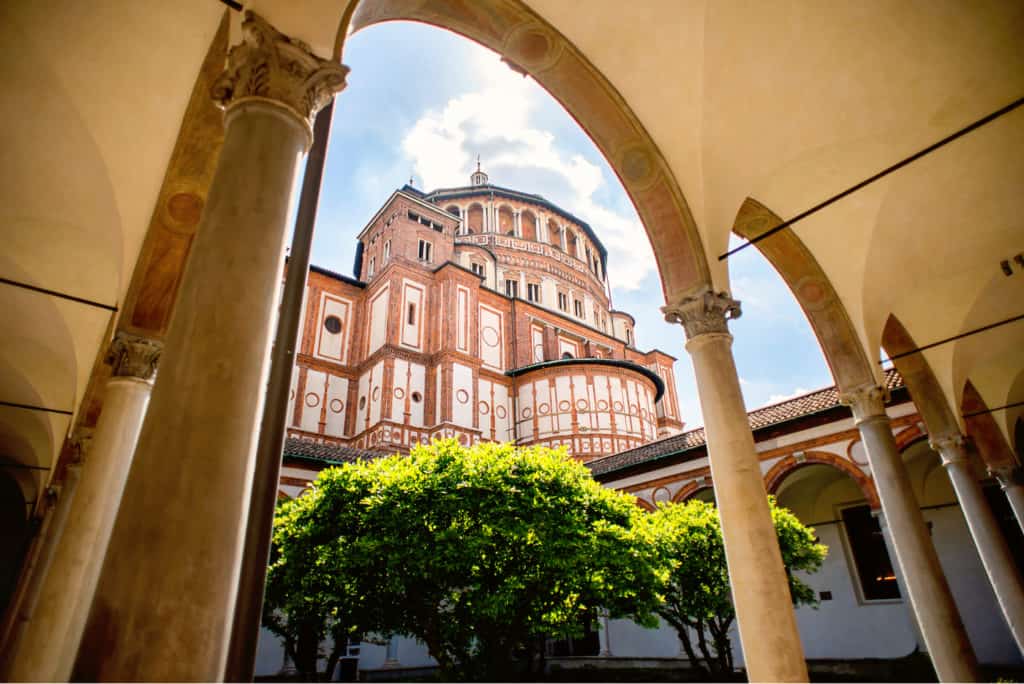
Santa Maria delle Grazie
Don’t neglect to see the pretty UNESCO-listed Renaissance church of Santa Maria delle Grazie while seeing the Last Supper. The church was started in 1465 but subsequently enlarged when Sforza duke Ludovico del Moro decided to place his mausoleum there.
To embellish the church, he hired Leonardo to paint The Last Supper and famedarchitect Donato Bramante to create the terra-cotta and cream-colored choir in 1492.
There is no entry fee.
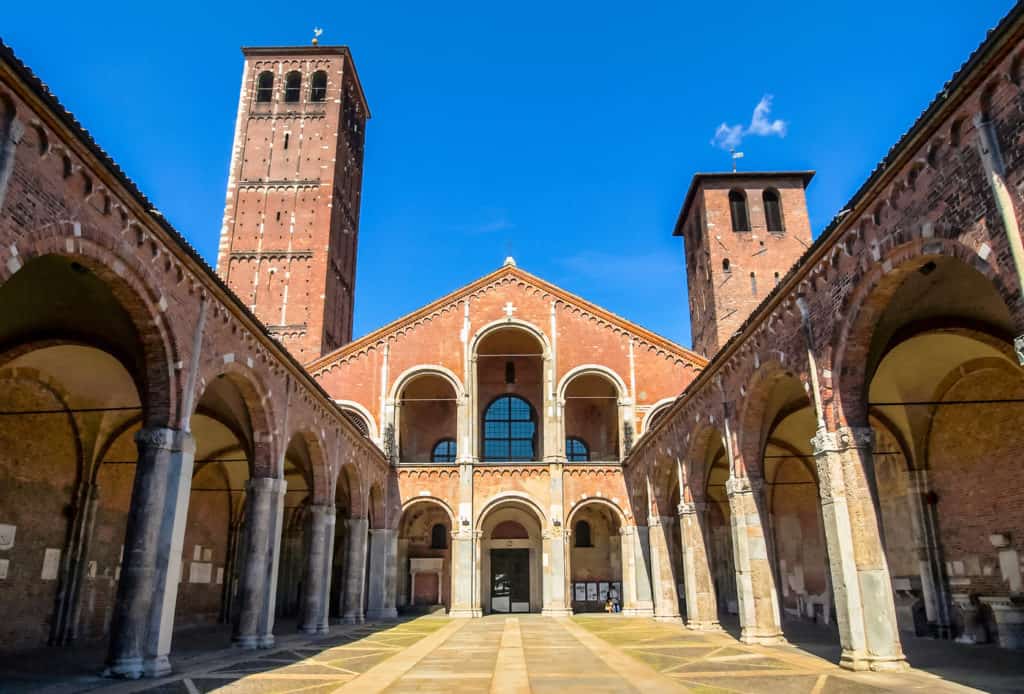
St. Ambrose Basilica
St. Ambrose was the bishop of Milan in the 4th century AD. He constructed a basilica on this site of which little remains, but the 11th century Basilica of Saint Ambrose that took its place is one of the best churches to visit in the city. Ambrose is the city’s patron saint, and his remains are in a glass case in the crypt below the altar, and are dressed in religious robes.
The basilica has a gold altar from when Charlemagne spent time in Milan, and a chapel with bits of a Tiepolo fresco cycle that was largely destroyed by WWII bombs. What you can see of the original church is the Sacello di San Vittore in Ciel d’Oro, a chapel whose cupola contains marvelous mosaics of saints from the 5th century. Its golden sky dome is supported by griffins and winged monkeys.
There is free admission for the church, but a 2€ fee to see the Sacello di San Vittore.
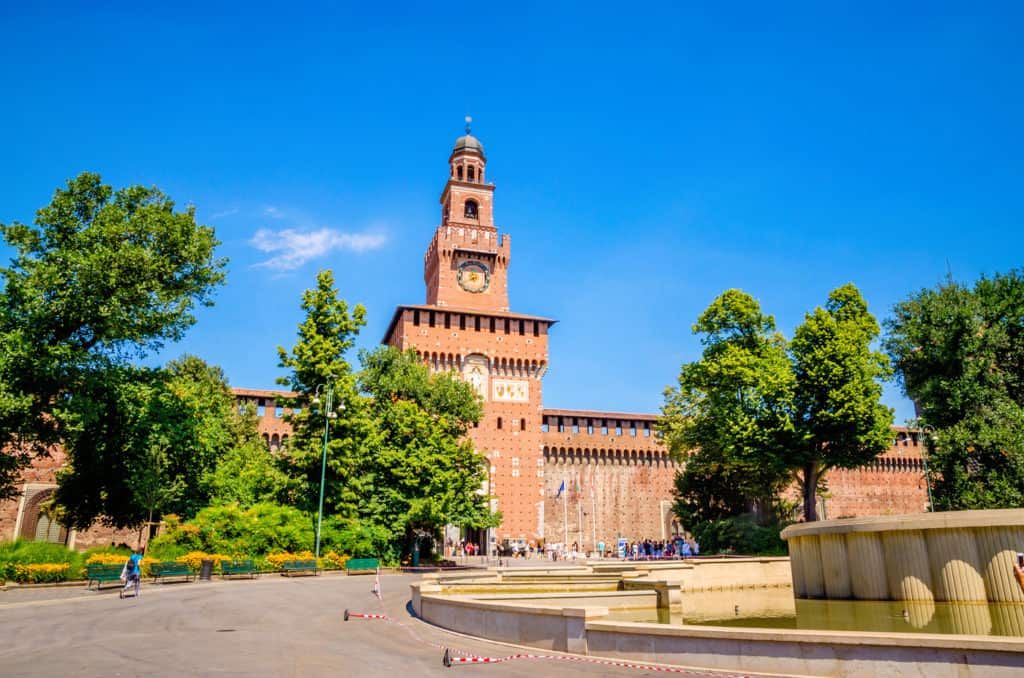
Milan’s Ducal Castle: Sforza Castle
This historical landmark was begun by one ruling Renaissance family, the Viscontis, and then rebuilt as the fortress home of the Sforza family. The Castello Sforzesco was the former seat of the Dukes of Milan.
Today, the castle houses various museums: the Pieta Rondanini Museum dedicated to showing the final sculpture of Michelangelo, the Museum of Ancient Art, the Archaeological Museum, the Museum of Decorative Arts., the Furniture and Carved Sculpture Museum and the Musical Instruments Museum. I think the best of the lot are the Michelangelo and Ancient Art Museums plus the Art Gallery, but your own tastes will guide how you’d like to allocate your time. Clearly there is too much here to digest in one visit. Allow some time to enjoy the setting by wandering around the Castle courtyard and walls.
The Rondanini Pieta was Michelangelo’s final, unfinished work, found in his Rome studio after his death at 89. It exemplifies suffering through its portrayal of the dead Christ and was likely intended by Michelangelo for his own tomb. It was purchased by the city in 1951.
Leonardo da Vinci was an artist working for the Sforza family, and in addition to helping to design the castle’s defenses, he painted an elaborate fresco in the castle’s great hall, the Sala delle Asse or Room of the Planks. The name referred to an interior room of the castle where the wooden wall covers would help keep it warmer in winter. Da Vinci’s same dry fresco technique that helped make the Last Supper deteriorate rapidly was used here as well, and little remains of the fresco now despite several restoration efforts. Painted from 1482-99, it depicts a garden pergola with 16 mulberry trees bound together by a golden rope. The sala is currently closed as it undergoes a fresh round of restoration efforts.
The Museum of Ancient Art, displayed in the ducal apartments, contains historical sculptures, including a magnificent equestrian tomb of Bernarbò Visconti. The picture gallery or pinacoteca contains over 200 works from the medieval age to the 18th century, including works by Bellini, Canaletto, Mantegna, and Bellotto.
Entry to the Castle courtyards is free, but the charge for entry to the museums is € 7.
Learn more about the history of Sforza Castle and see Michelangelo’s final sculpture on this 1.5 hour tour guided Castle tour for $56.32 per person.
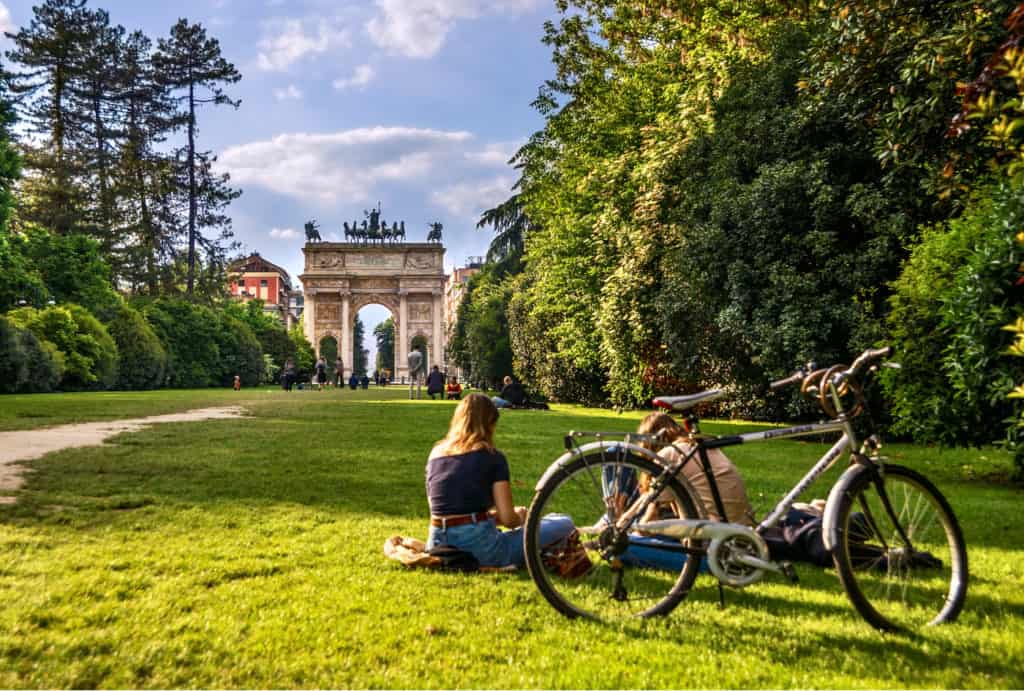
Parco Sempione: A Touch of Green in the City
The most centrally located park in the city is Parco Sempione, which expands out from the rear of the Sforza castle. This was once the hunting reserve of the Sforza dukes. Here you can enjoy a break from touring as you stroll through pleasant surroundings including a large lake, historic buildings like the 1807 Civic Arena built by Napoleon and the triumphal arch called the Arco della Pace, museums like the Milan Aquarium and the Triennale Design Museum and plenty of open spaces to have a picnic.
Look out for Branca Tower, designed in the 1930s by Gio Ponti. This observation tower has an elevator that can whisk you to the top for panoramic views of the city and countryside and on to the mountains.
Exploring Neighborhoods by Foot
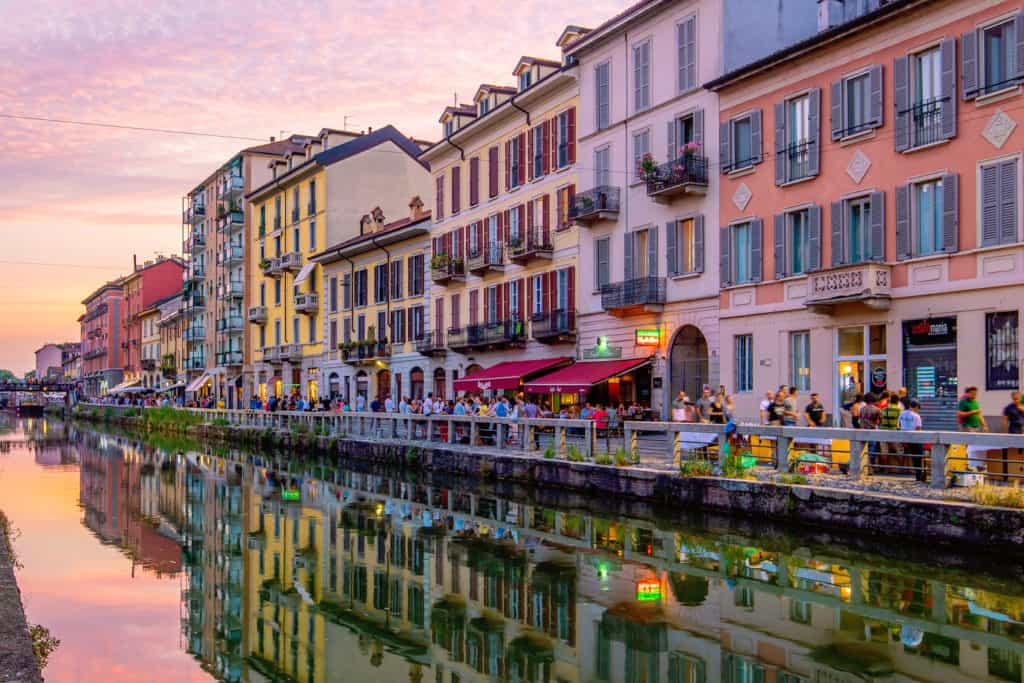
The Navigli District
The Navigli district of Milan has two remaining canals (Naviglio Grande and Naviglio Pavese) that in the past brought goods into the city (along with the marble for the Duomo). Some of the canals were covered over, but these two remain as the heart of a district that has in recent years developed into an artistic hub, filled with galleries, shops and restaurants along cobblestoned streets. There’s also a large vintage flea market held here the first Sunday of every month.
Boat rides are offered on the canals during the day (the Naviglio Grande is the more scenic choice), and at night, it’s a great place to come for your aperitivo crawl.
Learn more about the area on a three-hour guided walking tour of the Navigli district that also includes a visit to the Basilica of Sant Eustorgio for $116.28 per person.
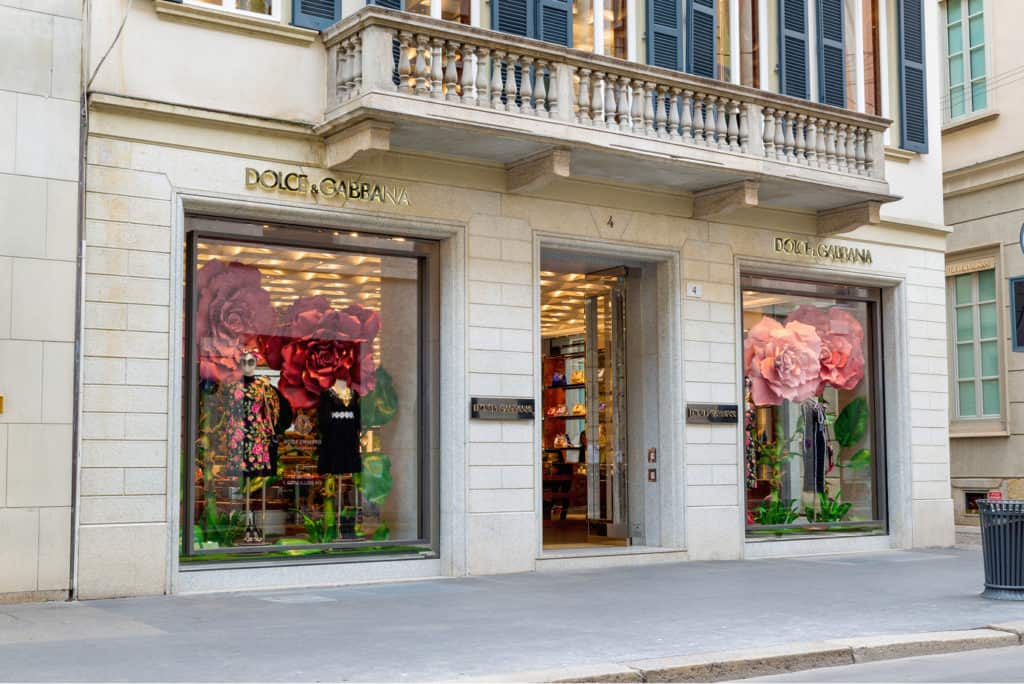
Walk The Fashion District
Milan is Italy’s fashion and design center, and there’s no better place to experience the shopping heart of the city than in the Quadrilatero della Moda (literally ‘fashion square’), also known as the Quadrilatero d’Oro or golden square, just a short distance from the Duomo. Here is where you’ll find the priciest and most spectacular stores. The most famous shopping streets are Via Monte Napoleone and Via della Spiga. Here are all the big names in shoes, jewelry and clothing, and window shopping alone is a tantalizing experience.
Food and Drink Specialties of Milan
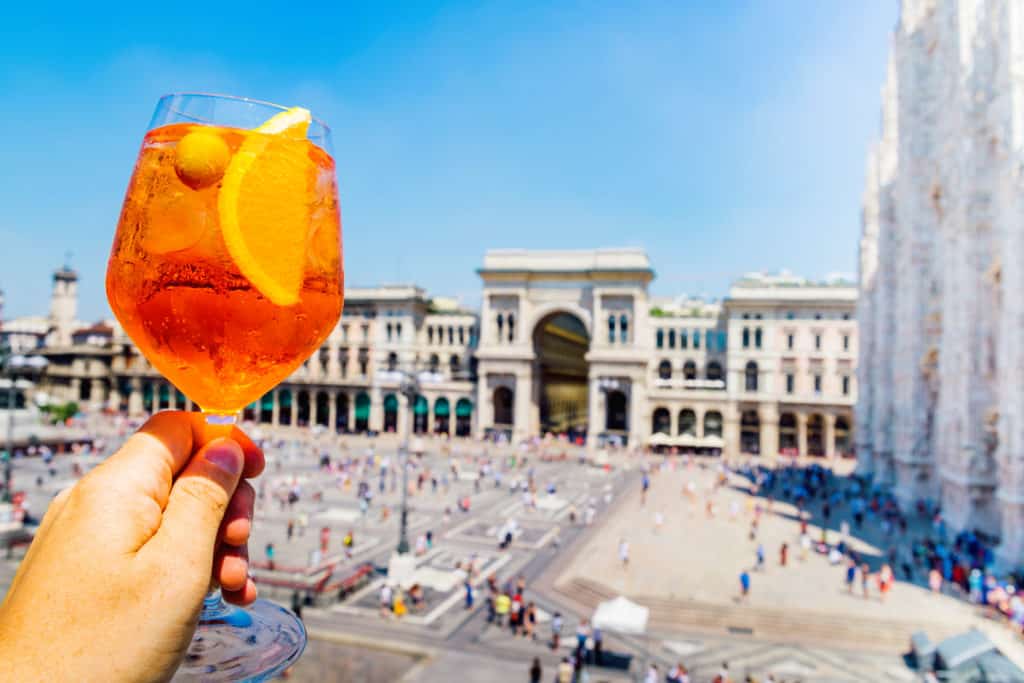
Do an Aperitivo Crawl
Milan has perfected the fine Italian art of aperitivo. Gather up some friends and head out to one or more convivial cafes or bars offering drinks plus a free attractive buffet spread along with it. Stroll from one bar to the next, sampling the different taste treats along the way with each drink you purchase. It’s a great pre-dinner activity for people watching and walking through picturesque surroundings until the dinner hour (or make it dinner by itself)!
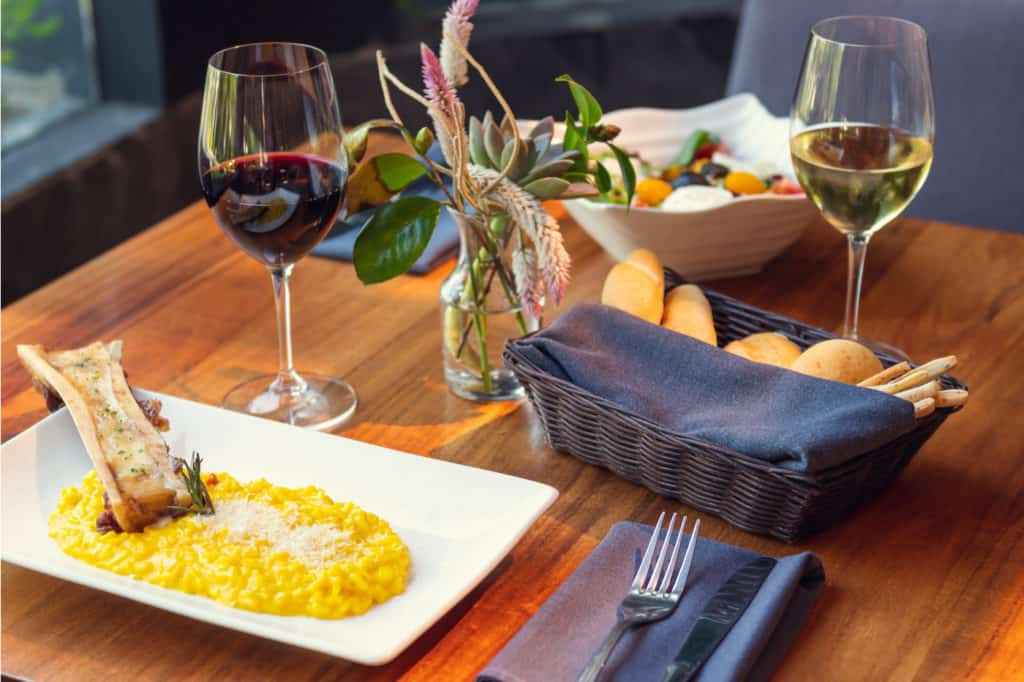
Discover some of Milan’s Specialty Dishes
Milan is the largest city in northern Italy and has its own cuisine and special dishes. Rice is the base for many dishes instead of the pasta used further south in the country. Take the time to seek out some of the best-known Milanese dishes during your stay in the city, including:
- Risotto alla Milanese
- Polenta
- Veal Milanese
- Gorgonzola cheese
- Ossobuco
- Panettone
- Panzerotto
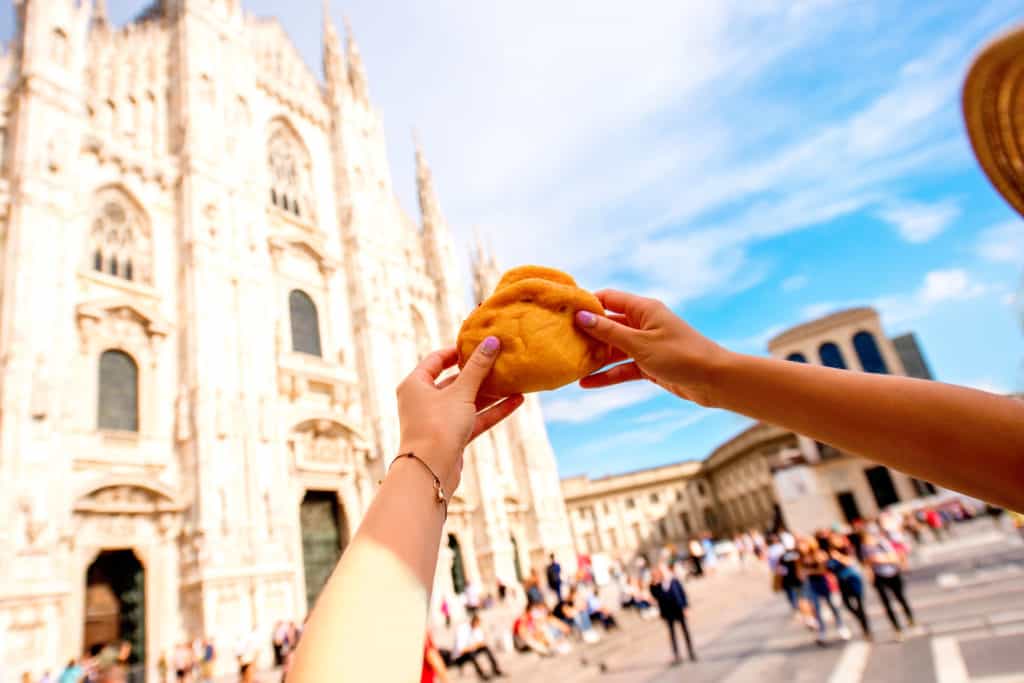
Try a Food Tour
While we’re on the topic of culinary adventures in the city, here are some tours that will connect you with local experts who can give you some great food experiences while in Milan.
Consider the 3-hour food and secrets tour with dinner in a local restaurant for $174.98 per person. If you’d like to know more about the pastries on offer here, this 2.5-hour pastries tour will take you to some of the best patisseries for $77.88 per person. If you’d like to get hands on with a 3-hour private home cooking class, you can do that too for $163.69 per person!
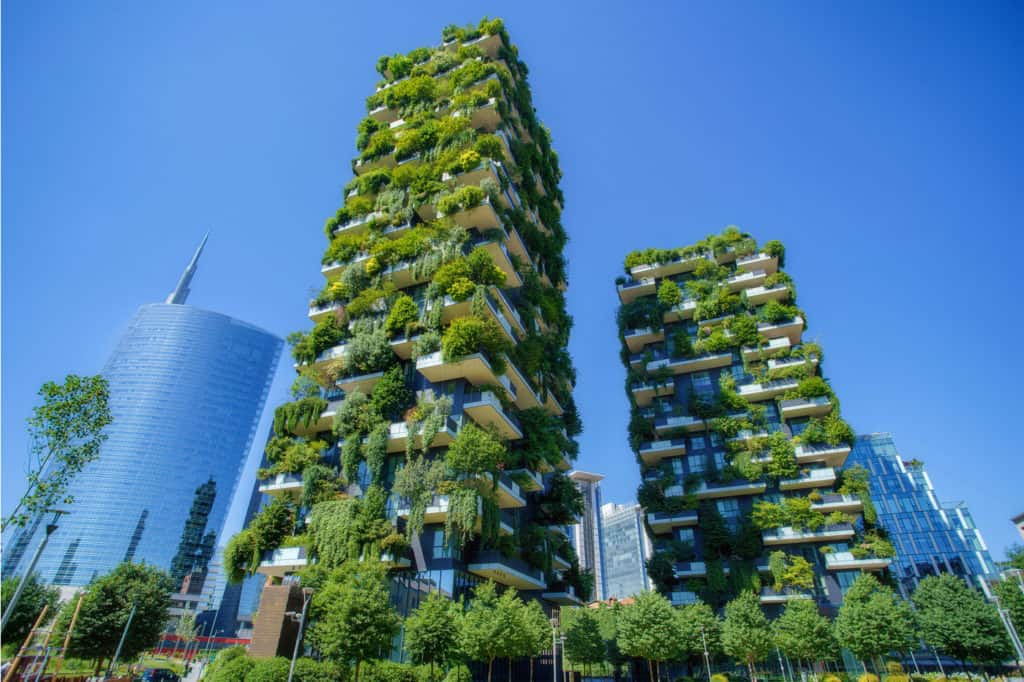
As Italy’s second largest city, Milan has a reputation as a busy New York-style metropolis. It is the banking and design capital of the nation, so business is important here.
But I hope that this review of some of the great things that Milan has to see and experience will help convince you that there’s much more to Milan in a historic and artistic sense, and it deserves a place on any Italian tour itinerary.
Related Articles on Italy
🏛 23 Things to Do in Rome, Italy
💰 The Cost of Travel in Rome: A 2023 Budget Breakdown
🚤 53 Best Things to Do in Venice
🛬 How to Make the Most of a Layover in Venice
🍕 The Absolute Best Things to Do in Florence, Italy
🍹 21 Incredible Things to Do in Bologna, Italy
🍝 23 Magical Things to Do in Siena, Italy
🍷 16 Amazing Things to Do in Lucca, Italy
🎉 Liberazione: What to Expect From Italy’s Liberation Day

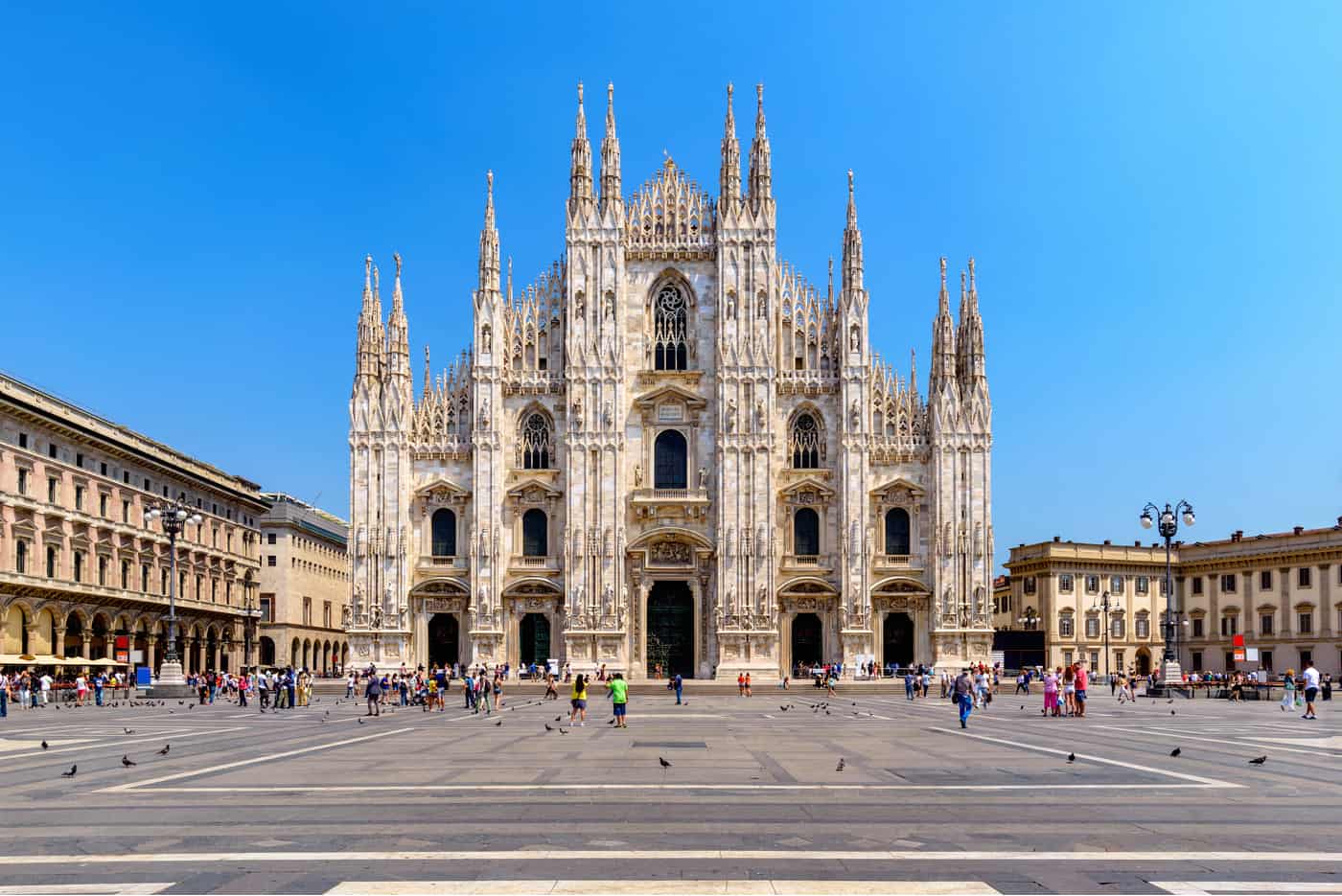


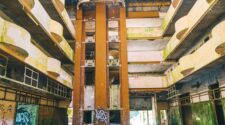
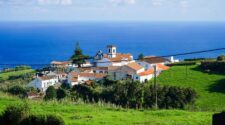
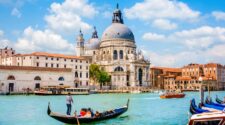

No Comment